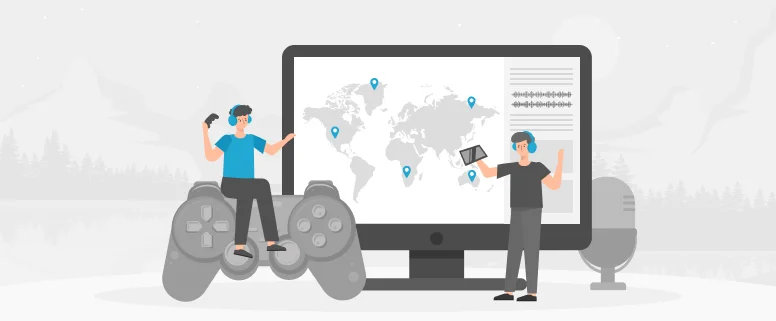Japan has one of the most lucrative video game markets in the world. It comes in third place after the U.S and China. Japanese gamers are the third largest spenders of money per user. The amount increases to around $371 annually. These figures, along with Japan’s strong mobile gaming market make Japan an attractive target market for video game creators.
How can you reach Japanese gamers the best way? And the answer to that question is, through Video game localization. In this article, we will cover some tips and best practices for localizing games for Japanese audiences.
Linguistic and Cultural Fluency
There is one aspect that needs to be clarified. Translation and localization are two different things. Translation translates text from one language to another, while localization adapts the user experience to the local context. This means that you must take into account cultural and linguistic nuances when adapting video games.
In Japan, many topics are taboo and censored.
- Violence: Japan bans murder, torture, gore, and other violent depictions. It is advised that players do not assume the role of a killer and that children and innocents are not victims of violence.
- Drugs: Drugs are considered taboo in Japan. They are subject to strict penalties. (cannabis especially). This taboo extends to video games, where drug use depictions must be avoided or removed.
- Religion: The two main religions of Japan are Shintoism (Shintoism) and Buddhism (Buddhism). However, the majority of the population is quite secular. Avoid games that promote or depict a particular religion.
Registration
Remember that registration is very important in the Japanese Language. There are many levels of politeness and honorific speech, which change depending on the relationship/social status between the parties involved in the conversation.
When translated directly into Japanese, imperative speech (e.g. “You have to finish this”) can come across as direct and rude.
Gender
Gender is also important because the personal such as pronouns for males and women (I, me), are different. The following are key points to remember:
- Single vs. plural: Japanese nouns don’t have plural forms, except for counting people. The word “tachi”, for people, is used to signify more than one person. Hito (one person), hitotachi (many people).
- Idioms: Translating an English phrase like “the quarantine had her climbing up the walls” into Japanese will sound absurd. It is better to find an equivalent expression in the target language, which captures the same meaning (this does not only apply to Japanese localization).
- The truncated text expands from English into Japanese. If there isn’t enough space in the window for text or graphics in the game, it may be cut off. This can be avoided by leaving enough space in the text window to allow for text expansion.
- Name/Date Formats in Japanese: Names are written with the surname first and then followed by one’s given names. The year/month/day format is followed by dates.
Another tip: Japanese is always evolving. The Japanese Ministry of Education constantly revises the official spellings of words each year using all three Japanese writing systems (kanji, hiragana, and katakana).
It is a good idea to have a Japanese-speaking team in Japan do the translation, and assist with localization.
Localization Best Practices
It is a good idea to keep the Japanese locale in mind at all stages of the game’s production. This will avoid the text window problems and taboos mentioned in the previous section.
- American game companies want to copy Japanese phrases when translating a game into English. This involves having a representative from the original game in the localization process. Translation and localization should be considered for any text in the game, such as the user interface or subtitles.
- A list of all the unique items in the game should be prepared for the localization team. It should include all synonyms and terms used to describe each item (e.g. gun = pistol, handgun) and what terms are similar to distinguish distinct items to avoid confusion.
- A special note should also be included for the localization staff regarding when to use a particular synonym for an item (if applicable) and what the connotations are.
- Particularly for Japan, where perfection and attention to detail are paramount, localized versions must also adhere to strict linguistic quality control (QA).
- A native Japanese-speaking team should perform QA, ideally located in Japan. Native speakers would be better equipped to spot linguistic inconsistencies, such as when a male character begins using the personal pronoun “Boku”.
- If a character uses slang in a game or has a specific accent, it is appropriate for the Japanese voice-over to use that accent or slang. The Kansai dialect, spoken in the southwest region of Tokyo, is a good substitute for characters with a New York accent or a Southern accent in American English.
- Another good practice is to ensure that localization teams play the video game starting at the beginning of the localization process.
This helps the team to become familiar with the game’s tone, text appearance, and other localization considerations. It is important to fully understand the scope and tone of a project before it becomes a problem. This can have a significant impact on the localization strategy as well as the success of the localization.
It’s not surprising that Japanese companies are keen to localize their games.
Below we will discuss the localization of games and the challenges that Japanese markets face. Here are the details on how to localize the video game.
- Making a Localization Tool
First, create a localization toolkit. This will allow you to communicate all the information you need for your game to translators. The toolkit will include everything that translators need to know about your game: brand considerations, content analysis, project plans, and brand considerations.
- Importing and exporting strings
You will need to import and export strings, just like websites. Developers who know coding will be able to tell you that you must pull strings to translate your code. Then you need to import the strings into a management program.
The characters and symbols will need to be entered into the processing system. Japan is different so make sure to localize numbers, dates, and times. You should be aware that different operating systems have different localization standards.
- Translating Content
Your translator is responsible for translating your content. He /she will review the tool kit and then proceed to translate your content using the management system. This will be handled by your Japanese localizer.
- Localizing Non-Textual Elements
Localizing dialogue, subtitles, and names for games are essential. You should consider changing the appearance of a city or the names or looks of its inhabitants. This stage will also include design.
- Quality Assurance
A quality assurance team is a key part of any localization company. They are responsible for proofreading, ensuring that the development aspect runs smoothly, and catching any errors in the process.
Three Challenges in Japanese Game Localization
Every localization project that is perfectly tailored for another language or country will face challenges. This complete guide will help you take your game localization to new heights. These are some of the challenges that Japanese localization faces:
- Keep some English. English is a common feature in Japanese video games. You will want to include some English in your game, particularly the ones that are familiar to your players. It would be awkward to have no English.
- Remember to consider gender. Japan has different speech styles. If you have a little girl, your speech styles should match.
- Contextual translation. The Japanese localizer should translate from the context information in the game. Some agencies may consider game localization to translate documents. However, this shouldn’t be the case every time. The game should be tested by your localization team for designs, visuals, and other cultural aspects.
We now reach the final, but most important aspect of localization: testing.
Conducting Localization Testing
Localization testing is an important aspect of localization. Your localization tester must conduct tests to make sure that the key elements work properly.
This is important for both the content and the user interface (UI). The localization testing must be limited to Japan (and not globalization testing which ensures that the website works in any language or culture). Tech processes include a user interface (UI), extraction, linguistics, functionality, project management, etc.
- Be Aware of Your Voice Tone
Japan is known for its politeness, which can confuse foreigners. There are many ways people can express themselves depending on their social status and relationship.
However, because the English source language is often casual, it’s difficult to translate the text for Japanese markets. An imperative form in Japanese is too assertive and can give the wrong impression.
Therefore, Japanese personal pronouns can be used in different situations depending on what the individual is talking about and what attributes they wish to display (e.g. masculinity, power, or confidence). Both in casual and formal settings, “me”, and “I” will sound very different. People can even list their such as pronouns on their online pages.
- Preparation of The Text
The text must be prepared before translating into Japanese. To ensure that the Japanese text is translated correctly, it is important to follow strict gender-related guidelines.
A male character speaking in a feminine tone will be spoken by a female character, while a female character will use a male voice. This makes it difficult to play the game in Japanese.
- Transliteration
Although Japanese strings are shorter than English strings, their transliteration length can be longer. This could cause problems in the localization of mobile games. Transliteration is a popular method for translating Japanese games.
- Use placeholders
In Japanese, the order is “Subject + Obj + Verb”,which is quite different in English. Although it may sound strange to say “I games play” in English, this is the correct order in Japanese. To improve translations, insert a placeholder into the source text.
- Don’t forget English UI
Japan has a low level of English proficiency. Japanese gamers are open to English interfaces, despite this. To determine if you need complete interface localization, consult your loc manager. Do not try to translate everything.
Because English is an integral part of Japanese gaming culture, local players will be familiar with English phrases and titles. Gamers expect to see English in games. A game without English might seem strange. All menus, UX text, and messages to gamers are in English.
- Avoid Controversial Topic
Some issues in Japanese video game culture will be met with hostility.
You should not promote religions, cigarette products, or narcotics within your game. Double-check that your cultural ideas or features are Japanese and not Chinese. This is because they are often confused with Chinese culture, which Japanese gamers won’t tolerate.
- Pay Attention to Symbols & Colors
Japan has a lot of symbols and colors that have important meanings. Four (4) sounds like “death,” while four items in a bundle can be described as negative. The term “W” is often used to denote doubled items. However, it can also be used to mean “laugh” in live communication.
Japanese gamers are as concerned about the graphics of their games as they are about the storyline. Female gamers love detailed images in soft, pastel manga-style colors.
- Avoid Violence
Japan’s video game industry has become self-regulatory in response to media criticism. Games are not often banned in Japan. However, some titles that contain excessive violence have been changed. Two important rules to remember: Gamers shouldn’t be tortured or killed, and children and innocent persons should not be killed.
- Make a list with references for Japanese translators.
The more extraordinary the number, the better. A simple sentence can be translated in many different ways. Gridly is a game CMS that allows translators to directly ask questions, greatly improving localization quality.
Japanese gamers are often annoyed by common errors in game translations such as singular errors, translated idioms, and shortened texts. Make sure to proofread all content. You can also order translation quality assurance. This allows translators the opportunity to play the game and find any extra VO or dubbing problems.
Wrapping Up
Perfectionism is key to success in Japan. If the product, app, or game isn’t great, neither are the people trying to sell it. Companies that specialize in localizing English games for Japan are aware of this.
Hence, if you want to compete in this market, it’s imperative that you consider all the options that are mentioned above. And put yourself in the best position possible.



